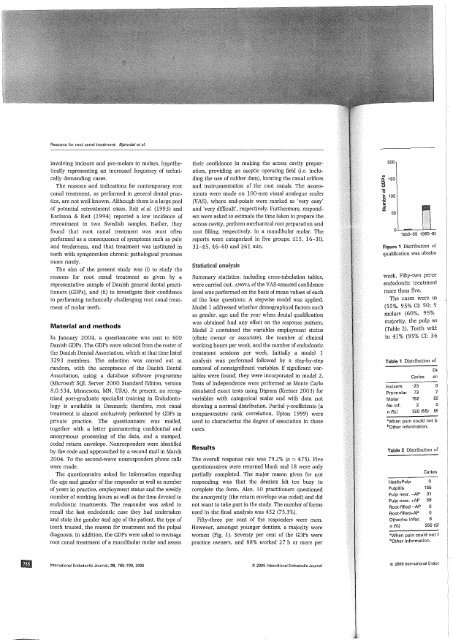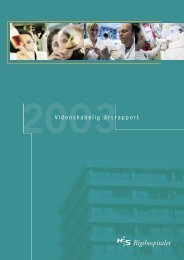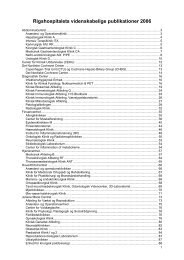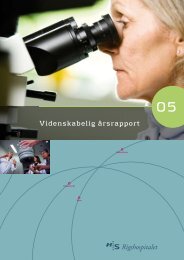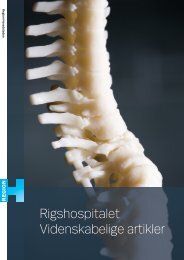View - CTU
View - CTU
View - CTU
You also want an ePaper? Increase the reach of your titles
YUMPU automatically turns print PDFs into web optimized ePapers that Google loves.
Reasons for root canal treatment Bj¢rndal et al.<br />
involving incisors and pre-molars to molars, hypothetically<br />
representing an increased frequency of technically<br />
demanding cases.<br />
The reasons and indications for contemporary root<br />
canal treatment, as performed in general dental practice,<br />
are not well known. Although there is a large pool<br />
of potential retreatment cases, Reit et al. (1993) and<br />
Karlsson & Reit (1994) reported a low incidence of<br />
retreatment in two Swedish samples. Rather, they<br />
found that root canal treatment was most often<br />
performed as a consequence of symptoms such as pain<br />
and tenderness, and that treatment was instituted in<br />
teeth with symptomless chronic pathological processes<br />
more rarely.<br />
The aim of the present study was (i) to study the<br />
reasons for root canal treatment as given by a<br />
representative sample of Danish general dental practitioners<br />
(GDPs), and (ii) to investigate their confidence<br />
in performing technically challenging root canal treatment<br />
of molar teeth.<br />
Material and methods<br />
In January 2004, a questionnaire was sent to 600<br />
Danish GDPs. The GDPs were selected from the roster of<br />
the Danish Dental Association, which at that time listed<br />
3293 members. The selection was carried out at<br />
random, with the acceptance of the Danish Dental<br />
Association, using a database software programme<br />
(Microsoft SQL Server 2000 Standard Edition, version<br />
8.0.534, Minnesota, MN, USA). At present, no recognized<br />
post-graduate specialist training in Endodontology<br />
is available in Denmark; therefore, root canal<br />
treatment is almost exclusively performed by GDPs in<br />
private practice. The questionnaire was mailed,<br />
together with a letter guaranteeing confidential and<br />
anonymous processing of the data, and a stamped,<br />
coded return envelope. Nonresponders were identified<br />
by the code and approached by a second mail in March<br />
2004. To the second-wave nonresponders phone calls<br />
were made.<br />
The questionnaire asked for information regarding<br />
the age and gender of the responder as well as number<br />
of years in practice, employment status and the weekly<br />
number of working hours as well as the time devoted to<br />
endodontic treatments. The responder was asked to<br />
recall the last endodontic case they had undertaken<br />
and state the gender and age of the patient, the type of<br />
tooth treated, the reason for treatment and the pulpal<br />
diagnosis. In addition, the GDPs were asked to envisage<br />
root canal treatment of a mandibular molar and assess<br />
their confidence in making the access cavity preparation,<br />
providing an aseptic operating field (i.e. including<br />
the use of rubber dam), locating the canal orifices<br />
and instrumentation of the root canals. The assessments<br />
were made on 100-mm visual analogue scales<br />
(VAS), where end-points were marked as 'very easy'<br />
and 'very difficult', respectively. Furthermore, responders<br />
were asked to estimate the time taken to prepare the<br />
access cavity, perform mechanical root preparation and<br />
root filling, respectively, in a mandibular molar. The<br />
reports were categorized in five groups: $15, 16-30,<br />
31--45, 46-60 and 261 min.<br />
Statistical analysis<br />
Summary statistics, including cross-tabulation tables,<br />
were carried out. ANOV A of the VAS-assessed confidence<br />
level was performed on the basis of mean values of each<br />
of the four questions. A stepwise model was applied.<br />
Model 1 addressed whether demographical factors such<br />
as gender, age and the year when dental qualification<br />
was obtained had any effect on the response pattern.<br />
Model 2 contained the variables employment status<br />
(clinic owner or associate), the number of clinical<br />
working hours per week, and the number of endodontic<br />
treatment sessions per week. Initially a model 1<br />
analysis was performed followed by a step-by-step<br />
removal of nonsignificant variables. If significant variables<br />
were found, they were incorporated in model 2.<br />
Tests of independence were performed as Monte Carlo<br />
simulated exact tests using Digram (Kreiner 2003) for<br />
variables with categorical scales and with data not<br />
showing a normal distribution. Partial y-coefficients (a<br />
nonparametric rank correlation, Upton 1999) were<br />
used to characterize the degree of association in these<br />
cases.<br />
Results<br />
The overall response rate was 79.2% (11 = 475). Five<br />
questionnaires were returned blank and 18 were only<br />
partially completed. The major reason given for not<br />
responding was that the dentists felt too busy to<br />
complete the form. Also, 10 practitioners questioned<br />
the anonymity (the return envelope was coded) and did<br />
not want to take part in the study. The number of forms<br />
used in the final analysis was 452 (75.3%).<br />
Fifty-three per cent of the responders were men.<br />
However, amongst younger dentists, a majority were<br />
women (Fig. 1). Seventy per cent of the GDPs were<br />
practice owners, and 88% worked 2 7 h or more per<br />
200<br />
VI<br />
Q. 150<br />
c<br />
(!)<br />
1ii<br />
~<br />
.0 '"<br />
E<br />
::I<br />
:z<br />
100<br />
50<br />
1950--59 196CH>S<br />
Figure 1 Distribution of<br />
qualification was obtain<<br />
week. Fifty-two perce<br />
endodontic treatment<br />
more than five.<br />
The cases were m<br />
(55%, 95% CI: 50; 5<br />
molars (60%, 95%<br />
majority, the pulp wi<br />
(Table 2). Teeth witt<br />
in 41 % (95% CI: 36<br />
Table 1 Distribution of<br />
Caries<br />
DE<br />
en<br />
Incisors •23 0<br />
Pre-molar 73 7<br />
Molar 152 52<br />
No inf. 2 0<br />
ni%1 250 (55) 5S<br />
awhen pain could not b<br />
bOther information.<br />
Table 2 Distribution of<br />
Caries<br />
HealtyPulp<br />
Pulpitis 155<br />
Pulp necr. -AP 31<br />
Pulp necr. +AP 58<br />
Root-filled -AP 0<br />
Root-filled+AP 0<br />
Other/no lnfor.<br />
n(%1 250 (5!<br />
"When pain could not I<br />
bother information.<br />
International Endodontic Journal, 39, 785-790, 2006<br />
© 2006 International Endodontic Journal<br />
© 2006 International Endoc


